|
"Certain
arrowheads have the end opposite the base rounded or flattened instead
of pointed."---1896,
Gerard Fowke, "Stone Art," 20th Annual Report of the Bureau
of Ethnology, p. 168.
"Edge scraping tools of varied forms were
in universal use by primitive peoples,---."---1919,
W. H. Holmes, "Handbook of Aboriginal American Antiquities," p. 346.
"Implements of
the scraper class are indispensable adjuncts of the arts of life among
primitive peoples. They take varies forms, serve many important
purposes, and are made of every available material."---1912,
Frederick Webb Hodge, "Handbook of American Indians North of Mexico,
part 2" p. 488.
"Exhausted Raddatz forms
occur in which the blade and shoulders have been totally reduced,
leaving only the haft element, the neck of which may exhibit a distal
bevel (i.e. hafted scraper)."---1987,
Noel D. Justice, "Raddatz Side Notched," Stone Age Spear
And Arrow Points Of The Midcontinental And Eastern United States, p.
67.
"The so-called stunner gets its name from speculation that
it was shot with a bow and arrow to merely stun or daze an animal,
rather than to penetrate or kill."---1986,
C. G. Yeager, "Arrowheads & Stone Artifacts A Practical Guide For
The Amateur Archaeologist,"
"C. C. Jones says that crescent-shaped
arrows were used by southern Indians for shooting off birds heads---."---1896,
Gerard Fowke, "Stone Art," 20th Annual Report of the Bureau
of Ethnology, p. 168.

END-SCRAPERS
MADE FROM PROJECTILE POINTS
EARLY ARCHAIC TO MIDDLE WOODLAND
PERIODS
ILLINOIS AND MISSOURI
Some of the earliest illustrations and descriptions of broken projectile
point bases that were reworked into end-scrapers appear in the late
1800's. They have been referred to as bunts, blunts, stunners and hafted
scrapers. There has been every kind of speculation as to how they were
used. It's been suggested that they were used as stunners to
knock out animals instead of killing them. Also, in one Smithsonian
report, in 1896, there is a reference to them having been used by
"southern Indians to shoot off birds heads!" Most people agree now that the majority
of them were probably used as scraping tools.
|
|
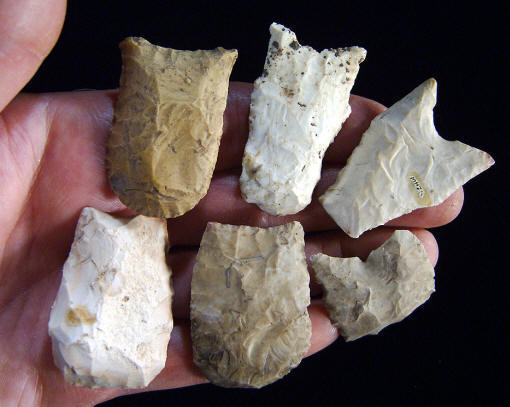
END-SCRAPERS
MADE FROM PROJECTILE POINTS
ILLINOIS
EARLY ARCHAIC PERIOD
These six Dalton and Dalton-like forms of projectile points were
reworked into end-scrapers. The ends were pressure flaked from one
side forming a beveled working edge. The two points at top right
have polished edges from very heavy use. The other points show
little or no use wear. The longest example measures 2 1/4 inches
(5.7 cm) long. |
|
|
Being frugal is
being prudent, careful and thrifty. So the salvaging of broken
projectile points and reworking them into scrapers might be a good
lesson in frugality. Salvaging broken points would seem to make sense
but actually only a few cultures made scrapers from broken points in any
significant numbers. The majority of them are found on sites east of the
Mississippi River. |
|
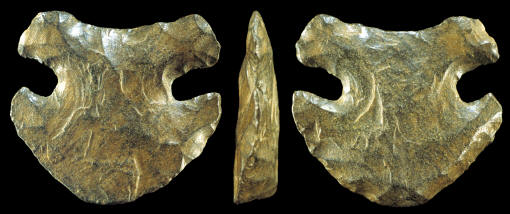
CLICK ON PICTURE FOR LARGER IMAGE
END-SCRAPER
MADE FROM PROJECTILE POINT
ILLINOIS
ARCHAIC PERIOD
This
picture shows three views of an Archaic side-notched point that
apparently broke either from use or during manufacture. A crescent
shaped edge was formed by pressure flaking one side to form a
beveled edge. The edge view shows the flaking pattern from one side. The
edge of this scraper is polished from use. This scraper measures 1
1/8 inches (2.8 cm) long and 1 3/16 inches (3 cm) wide. |
|
|
The Archaic and
Woodland periods produced most of the broken projectile points end-scrapers. During the early Archaic period, almost 11,000
years ago, the Dalton culture produced large numbers of them. During the
middle and late Archaic periods, side-notched Raddatz and Godar points
were also being remanufactured into scrapers in very large numbers. During
the Middle Woodland period the Snyders point is another example that was
made into hafted scrapers but in lesser numbers. |
|
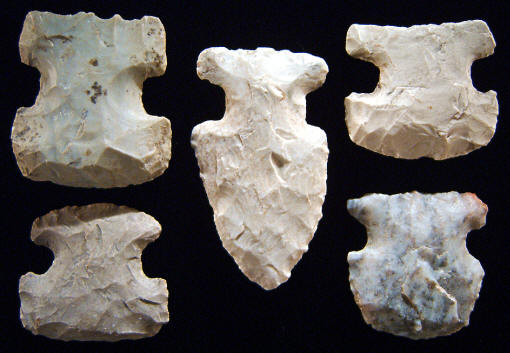
END-SCRAPERS
MADE FROM PROJECTILE POINTS
ILLINOIS
ARCHAIC PERIOD
This picture shows a complete Godar point and four Godar points that
were reworked into end-scrapers. These heavy duty side-notched
points date to the Middle to Late Archaic period. All of the
scrapers in this picture have use wear polish on the working edges.
Godar and Raddatz type side-notched point end-scrapers were made in large numbers. In fact, they
may outnumber any other projectile point type scraper in the
Illinois and Missouri region. |
|
|
The introduction of the bow and arrow during the late Woodland period
significantly reduced the size of projectile points making them less
useful as scrapers. It would not be impossible to discover an arrow
point made into an end-scraper but any traditional practice ends by this
time. |
|
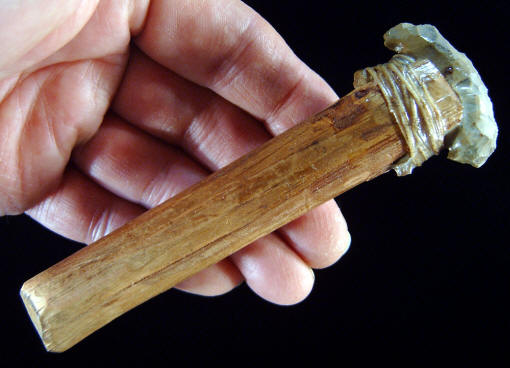
REPLICA OF HAFTED
END-SCRAPER
This hafted scraper was put together
by someone several years ago for a display in a museum. It's a
hypothetical example of how a projectile point scraper may have been
hafted onto a handle. The scraper is an Archaic stemmed point that
was trimmed into a crescent shape. It was reworked into a scraper by
pressure flaking from one side resulting in a beveled edge. This
handle is made of wood but ancient handles may also have been made
of antler or bone. This hafted scraper measures 5 inches (12.7 cm)
long. |
|
|
Clovis people were using broken projectile point bases as scrapers
12,000 to 14,000 years ago. Although they were not reworking the bases
into scrapers, some Clovis bases exhibit use wear along the existing
broken edge. The tradition of reworking broken bases didn't begin in any
significant way until the early Archaic period. |
|
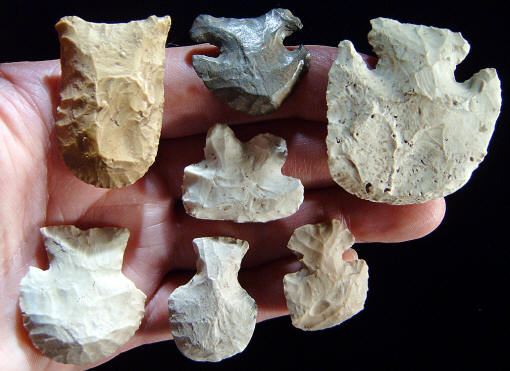
END-SCRAPERS
MADE FROM PROJECTILE POINTS
ILLINOIS
ARCHAIC PERIOD
This picture illustrates several different examples of Archaic point
types that were made into end-scrapers. Each one was made from a
different type of projectile point. The bottom points, from left to
right, are Hardin Barbed, Table Rock and St. Charles (Dovetail)
points. The scraper in the center was made from a bifurcated base
Lecroy point. The top row, from left to right are a Dalton point, a
side-notched point and a corner-notched point. The corner-notched
point, Lecroy and the Table Rock point show very heavy use wear. The
largest one is 1 7/8 inches (4.7 cm) long. |
|
|
Examples of end-scrapers made from reworked projectile point bases have been found on many
different point types. This report illustrates some of the more rare
examples such as St. Charles, Table Rock, Lecroy and Harden Barbed
points. These are exceptions and not a traditional trait normally found
on these point types. One consideration is that a later culture found an
earlier culture's broken point and reworked it into a scraper. |
|
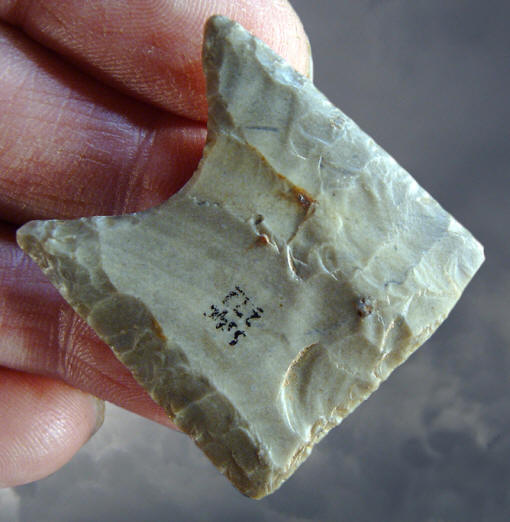
CLOVIS POINT
BOSTROM
SITE
ST. CLAIR COUNTY, ILLINOIS
Clovis points didn't have a
tradition of reworking their broken point bases into edge trimmed
scrapers. However, as this picture illustrates, they did utilized
some of their broken bases as scrapers. This broken Clovis base was
surface collected on the Bostrom site. The broken edge shows obvious
use wear that probably resulted from scraping. This Clovis point in
made of Cobdin chert and it measures 1 3/8 inches (3.5 cm) long. |
|
|
Most projectile point bases were made by reworking the broken edge with
pressure flaking from one side only. The resulting beveled edge is
usually
formed into a crescent shape. The exception is scrapers reworked by
pressure flaking the edge from both sides forming a straight unbeveled
edge. |
|
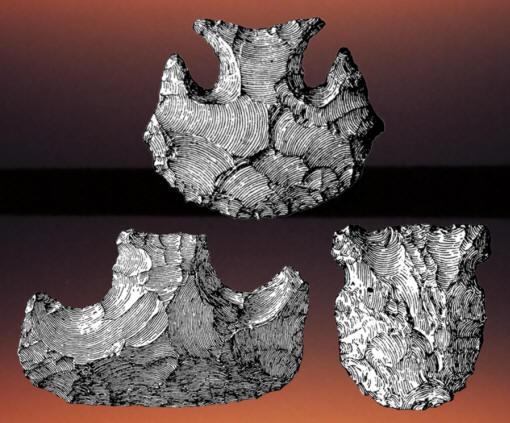
ILLUSTRATION DRAWINGS FROM 1891
ANNUAL REPORT OF THE BUREAU OF ETHNOLOGY
EARLY ILLUSTRATIONS OF
SCRAPERS
MADE FROM PROJECTILE POINTS
GEORGIA
AND WISCONSIN
These drawings were published by the
Smithsonian in 1891. They represent some of the earliest published
examples. The corner notched scraper at top is reported from
Georgia. It was reworked by pressure flaking the edge from both
sides to form a straight unbeveled edge. It's referred to as either
a blunt or a bunt arrowhead. One suggested use for this type of
point in the report is that it was used to shoot off the heads of
birds! The two bottom points were made into typical scrapers by
pressure flaking from one side to form a beveled edge. This early
report refers to them as stemmed scrapers. One example is from
Georgia and the other from Wisconsin. Suggested uses are, for
smoothing objects made of wood, cleaning hides and cleaning fish. |
|
|
Some broken projectile point scrapers may have been hafted onto
foreshafts and didn't need to be re-hafted. In fact they may have been
reworked while still attached to a foreshaft. End-scrapers were hafted
onto short handles made of either antler, bone or wood. Evidence of this
can be observed on some Eskimo tools such as the Thule example
illustrated in this report. |
|
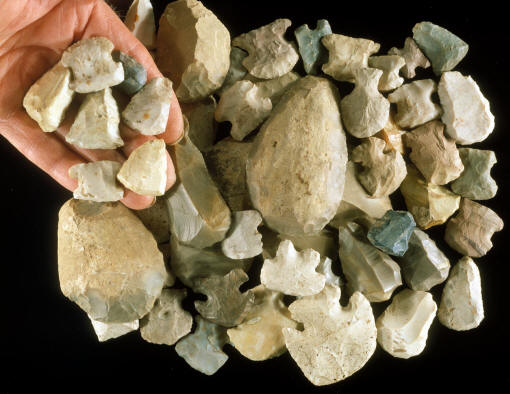
CLICK ON PICTURE FOR LARGER IMAGE
MISCELLANEOUS TYPES OF
END-SCRAPERS
ILLINOIS, KENTUCKY & MISSOURI
PALEO - ARCHAIC
This picture shows a large variety of
different types of end-scrapers. The most common examples are
unifacial scrapers made from flakes. They have been found in a wide
range of sizes and they were being produced beginning with early
Paleo through to the Mississippian periods. End-scrapers made from broken projectile points are
the rarest form. The largest unifacial scraper in this picture (in
the center) measures 3 3/8 inches (8.5 cm) long. |
|
|
Some hafted scrapers have extremely heavy use wear on their scraping
edges and others only minor use wear. But some have little or no use
wear at all. End-scrapers were used on organic materials such
as wood and animal hides. |
|
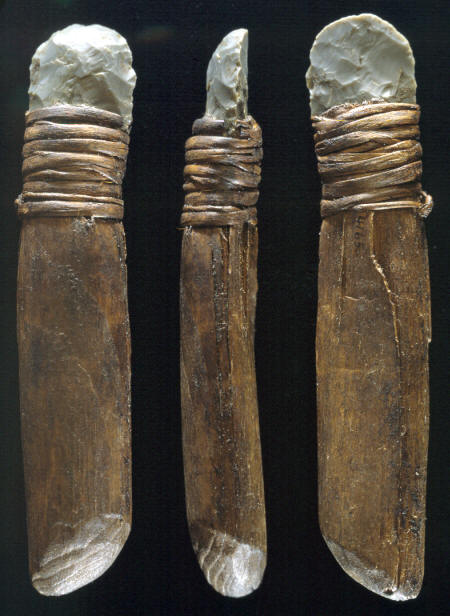
SMITHSONIAN INSTITUTION
COLLECTION
CLICK ON PICTURE FOR LARGER IMAGE
HAFTED END-SCRAPER
THULE
CULTURE
WALAKPA SITE, ALASKA
This Thule tradition hafted scraper
was made in Alaska approximately 600 years ago. The handle and fiber
hafting material is perfectly preserved. However, this scraper was not
made from a broken projectile. It was manufactured from a flake. It
illustrates how some or most end-scrapers may have been
hafted and used. This hafted scraper measures 4 7/8 inches (12.4 cm)
long. |
|
|
Projectile point scrapers may not seem all that exciting. After all,
they're just very simple utilitarian tools. But maybe it can be argued
that they're just a little more interesting because they were
remanufactured from a different tool type. Anyway, it was a thrifty
process and maybe a good argument for frugality. |
|
"REFERENCES"
1896, Fowke, Gerard, "Stone Art," 20th Annual Report of the Bureau
of Ethnology, p. 168.
1912, Hodge, Frederick Webb, "Handbook of American Indians North of
Mexico, part 2" p. 488.
1919, Holmes, W. H., "Handbook of Aboriginal American Antiquities,"
p. 346.
1986, C. G. Yeager, "Arrowheads & Stone Artifacts A Practical
Guide For The Amateur Archaeologist,"
1987,
Noel D. Justice, "Raddatz Side Notched," Stone Age Spear
And Arrow Points Of The Midcontinental And Eastern United States, p.
67.
|
|
RECENT
LISTINGS HOME
ORDERING |